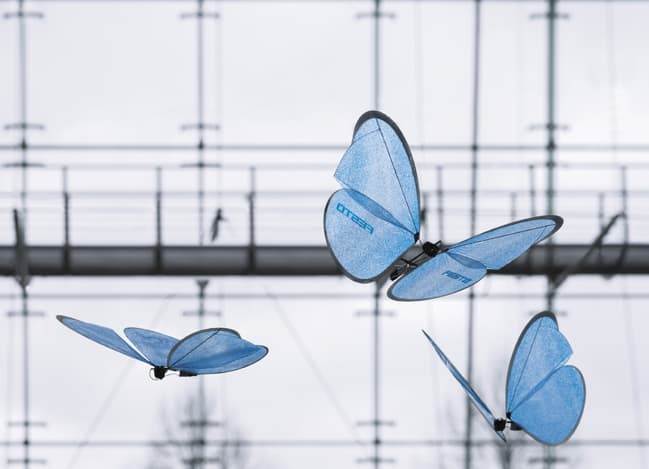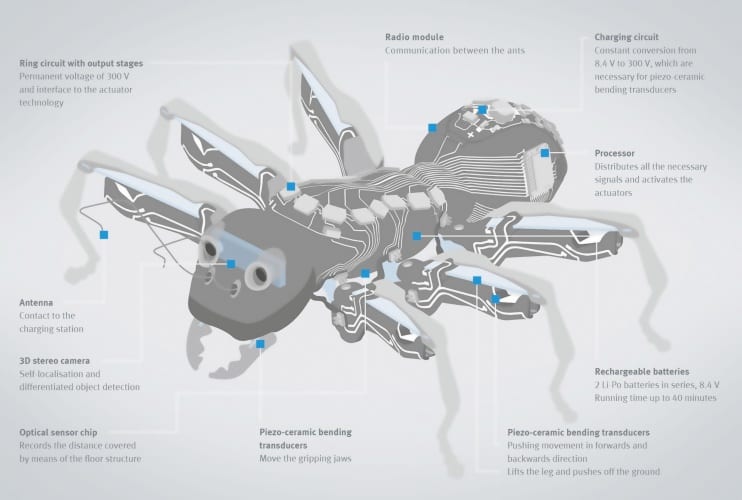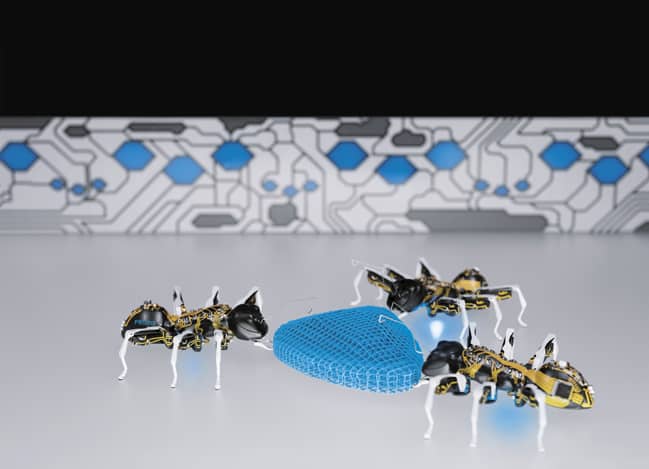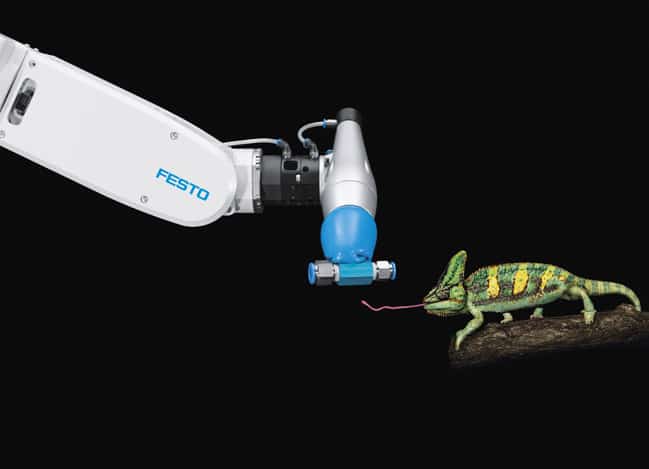
A spontaneous aerobatic display by giant robotic butterflies isn’t, sadly, a regular feature of the traditional factory tour.
But, late last year, this was exactly how German automation giant Festo chose to mark the opening of a flagship manufacturing facility in Scharnhausen, on the outskirts of Stuttgart. The giant 66,000-square-metre factory, now home to the firm’s valves and electronics production operations, is about as modern and hi-tech as manufacturing plants get. This, claims the company, is Industry 4.0 in action. A meticulous use of data; a relentless focus on energy efficiency; ‘co-bots’ on the factory floor and even touchy-feely breakout spaces more redolent of Silicon Valley, conspire to create the kind of ultra-modern facility that will surely become commonplace in the years ahead.
But it was notable that among the presentations at a conference convened to celebrate the plant’s opening, one topic Festo chose to focus on was its – some would say eccentric – obsession with bionics.
The company’s interest in the field, sometimes also known as biomimetics, is well known. In recent years it has unveiled a succession of astonishing and frequently beautiful robotic creations – seagulls, jellyfish, dragonflies, and even a robot kangaroo – that have grabbed the headlines and helped cement the perception that this is a company at the top of the innovation game.
But according to Festo’s Dr Heinrich Frontzek, who heads up the firm’s bionics work, while the research is undoubtedly an exceptionally effective marketing tool, that’s not its only value to the company.
Bionics has been an area of interest for the firm since the early 1990s. And although it accounts for a relatively tiny proportion of the company’s R&D budget it has perhaps become more
of a focus in recent years.
In 2006, the company established the Bionic Learning Network, a cross-disciplinary group of scientists and engineers tasked with developing a handful of concepts each year. And although none of the technologies emerging from the laboratory have yet made it directly onto the factory floor, there are signs that the research is becoming increasingly focused on solutions that could have industrial benefit sooner rather than later.
Increasingly, explained Frontzek, bionics is playing a very real role in helping to develop and inform the company’s understanding of some of the technologies that will become central to the future of manufacturing: areas like soft-robotics, wireless connectivity, energy efficiency and autonomy.
The natural world, he said, holds the key to many of the challenges faced by industry. Elegantly efficient approaches to movement, positioning, monitoring, process control and communication can all be found in nature and it would be wasteful, he said, not to make use of evolution’s vast repository technical solutions.
In one of the firm’s most striking recent projects, the group turned its attention to the ant: a creature that has long interested developers of intelligent systems.

In an effort to understand whether the famed collaborative behaviour of ants could be used to develop new approaches to intelligent systems the group developed bionic versions of the insects.
These so-called BionicANTs mimic precisely the anatomy of their natural equivalents. Tiny, highly efficient piezo-electric transducers are used to actuate the mouth pincers and the legs while a 3D stereo camera in the head and an opto-electronic sensor in the abdomen helps the ant understand its position.

The ants communicate with each other via a radio module located in the torso, and complex control algorithms ensure that rather than operating individually, each ant forms part of a multi-agent system that is able to carry out an intelligent division of labour.
During demonstrations, rather like their natural cousins, the bionic ants were able to work together to push and pull objects across a defined area.
Frontzek said that the lessons learned from the project are helping inform the company’s thoughts about future factories, which will be able to adapt flexibly to different production scenarios and thus take on tasks from a higher control level. “The BionicANTs communicate with each other and coordinate both their actions and movements,” he added. “Each ant makes its decisions autonomously, but in doing so is always subordinate to the common objective and thereby plays its part towards solving the task at hand.”
The group’s eMotionButterflies, which it also demonstrated at the Scharnhausen opening, represent another effort to find a natural solution to collective behaviour. These robot insects are able to coordinate flight paths so that they don’t collide with each other thanks to an indoor guidance and monitoring system, which uses a network of cameras around the room to constantly record the butterflies’ position. These cameras transmit the position data to a central master computer, which coordinates the butterflies from outside.
Frontzek said that the project has taught the team valuable lessons about real time-optimised communication between individual systems. “The eMotionButterflies will not fly through the factory of the future; rather, they will suggest new approaches to the functioning of a networked overall system or show us what future industrial logistics applications could look like.”
While in many cases these projects are fairly abstract, other more tangible technologies that could have direct industrial applications have also emerged through the route.
One particularly notable example is an industrial gripping mechanism, jointly developed with researchers at the Oslo and Akershus University College of Applied Science, which is modelled directly on the behaviour of a chameleon’s tongue.

When catching prey a chameleon shoots its tongue at high-speed towards its unsuspecting target. During this process, just before the tip of the tongue reaches its target the middle of the tongue retracts while the edges continue to move forwards. This enables the tongue to adapt to the shape and size of the prey and firmly enclose it. The Festo team mimicked this ability using a water-filled silicone cap, which wraps itself around the items being gripped in a flexible and form-fitting manner. The resulting device, the FlexShapeGripper, is thought to hold promise for any application where multiple objects with a range of different shapes are handled at the same time.
It’s tempting to dismiss Festo’s bionics work as a sideshow. But while it is the case that flying insect robots are a world away from its core business, there’s little doubt that the lessons it is learning from its eccentric specialism are becoming increasingly relevant to modern manufacturing.
On a broader level, the firm’s work highlights an enviable characteristic of German industry that we would do well to try and emulate in the UK.
Large German firms, particularly family owned concerns like Festo, owe much of their success to their ability to marry the immediate demands of the business with a more speculative, longer term approach that creates the freedom to innovate. Festo’s bionics work is perhaps one of the most striking examples of this in action.
Indepth: Biomimetics
In turning to nature for ideas, Festo joins a long line of engineering innovators keen to tap into the innovative solutions delivered by millions of years of evolution.
In perhaps one of the most well-known examples of the discipline Swiss engineer George De Mestral invented Velcro after studying burdock burrs that had become tangled up in his dog’s fur.
More recently engineers have developed new adhesives inspired by the Gecko’s feet, while defence industry developers of next-generation UAVs are taking their lead from insect flight.
As our knowledge and understanding of the natural world increases, we can expect to see ever more examples of biomimetics in the years to come from the development of self-healing structures and materials to morphing aircraft wings that help aircraft become more manoeuvrable and more efficient.




Poll: Should the UK’s railways be renationalised?
Rail passenger numbers declined from 1.27 million in 1946 to 735,000 in 1994 a fall of 42% over 49 years. In 2019 the last pre-Covid year the number...